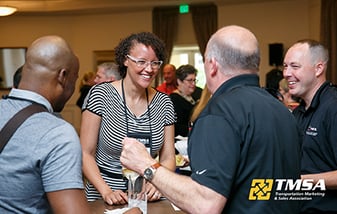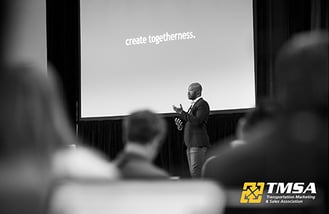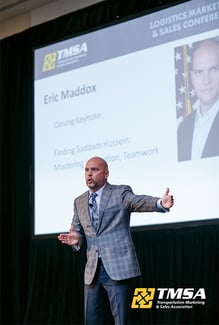Written By: Conrad Winter | Jul 3, 2019 12:00:00 AM
Why was I so surprised to feel connected when I attended the TMSA conference in Fort Myers earlier this month?
After all, transportation and logistics today is all about connecting—data, experiences, services, geographies, equipment—you name it. And the better you can connect, the more successful you become.
But I had never been to this conference before and, as an independent copywriter, I’m not the most outgoing person in the room. So, I expected it to be difficult to meet people and strike up conversations. I expected companies to huddle off by themselves and speak in hushed tones. Instead, people were quick to welcome and enlighten me. Time after time, groups invited me in to meet the gang.
And I learned so much from everyone. For example, I learned how drones are being used in warehouses and container yards, how there’s a not-for-profit that organizes companies in transportation and logistics to respond to natural disasters, and how gamification is about way more than, well, games.
That was just the whip cream on the key lime pie, too. The formal learning included great sessions on what big shippers really want, how sales and marketing need to be together and why on earth Google needs a fleet.
Here are the highlights from my personal track through the conference. Read on if you missed the ride, had trouble attending two sessions at the same time or aren’t a compulsive note-taker like myself.

The collegial and welcoming environment was helped greatly by the first event of the 3-day conference: speed networking. Not only did they get a great showing of people, but everyone there embraced the rigors of a two-minute meeting with a complete stranger. By the end, every one of the 40-50 people had, well, 40-50 people at the event they now knew. It was a brilliant concept: 20 tables, one person at each table stayed put, and everyone else rotated. It was amazing how much you can learn about another professional in 2 minutes. And it created an environment where people were more concerned with conversations and learning than just meeting people. It took the heat off, really. And that was only Sunday—the conference hadn’t even officially kicked off.
A great unifying theme can multiply the effect of a big event, creating synergies, spurring conversations, busting regular attendees out of routine expectations. This conference had a super sharp one. In all honesty, I didn’t even notice it on all the promotional materials until the keynote. And what an opening keynote Jeff Davis, the founder of The Sales and Marketing Alignment Summit, delivered. The theme was alignment between sales and marketing. As a marketer, it’s not a topic I’ve ever really given much thought to, I have to admit. (Jeff’s point exactly.) He made a case that no one in sales or marketing today can afford to ignore:
 Align with the new business landscape. According to CEB from six to eight people are involved in B2B buying decisions today. Jeff pointed out that means your message needs to be clear for everyone involved in the decision at every stage of the buyer’s journey. That means a clear value proposition, consistency throughout and a unified story. The fact that people change jobs frequently heightens these needs because people will likely be coming and going on the decision committee and they all need to be reading from the same page.
Align with the new business landscape. According to CEB from six to eight people are involved in B2B buying decisions today. Jeff pointed out that means your message needs to be clear for everyone involved in the decision at every stage of the buyer’s journey. That means a clear value proposition, consistency throughout and a unified story. The fact that people change jobs frequently heightens these needs because people will likely be coming and going on the decision committee and they all need to be reading from the same page.
67% of the buyer’s journey is now done digitally. Jeff believes that number from Sirius Decisions highlights people’s want for content before they talk to you, and he stressed that you want to be there to “control the conversation.” And if they’re making 12 searches on average prior to even visiting your site, that means you need to be where they search on trade organization sites, LinkedIn groups—you get the picture. With 57% of the purchase decision complete before the customer even calls a supplier (CES), you need to “be there to tee them up,” he said.
Your competition is not who you think it is. Indecision is the real enemy. Yep. Jeff describes the “paradox of choice” as pounding prospects with so many options, that in the end they go with the status quo, i.e. no decision. That’s why Jeff counsels companies to make the customer experience frictionless.
It’s all CX. Jeff gave this stat from Walker Information: Customer Experience (CX) will overtake price and product as key brand differentiators by 2020.
And CX is determined by how well sales and marketing align. Kaboom…That was Jeff’s sit-up-and-take-notice statement, and it was followed by a staccato of sensational stats for any nonbelievers left in the room and practical steps for those who were ready to get started.
Still not in an aligning state of mind? Jeff believes friction between these two groups leads to friction in the buyer’s journey. And misalignment between sales and marketing costs companies big time. How much? Jeff cited this from The B2B Lead (Reach Force): Lost sales productivity and wasted marketing budget cost companies at least $1 trillion a year.
Know thy counterpoint and prosper. Sales professionals and marketing professionals within organizations typically don’t know the challenges of their counterparts, according to Jeff, but they should. Companies who successfully align these sales and marketing experience on average 20% annual growth versus those with poor alignment whose revenue declines on average 4% per year. (Aberdeen Group) His point: listening to the needs of sales associates, changing the lens of how you see partnership and getting into conversation early have a big payoff.
Practical tips to take from Jeff:
Funnel or cone? Jeff points out that we live in an upside-down world where sales is moving to the top of the funnel by engaging prospects on social media while marketing is moving to the bottom by providing engaging content through the majority of the customer’s journey. And in this world, alignment has never been more important.
Ready, set, align. Every major endeavor starts with a simple step. Jeff’s suggestion is to get sales and marketing to agree on the why. And we got majorly insightful advice on doing that in the closing keynote.
 Because the opening keynote got things off to such an amazing bang. I wanted to note that it also ended with cannon fire and a deft message. Staff Sergeant Eric Maddox’s closing keynote took the conversation to new heights and a practical first step.
Because the opening keynote got things off to such an amazing bang. I wanted to note that it also ended with cannon fire and a deft message. Staff Sergeant Eric Maddox’s closing keynote took the conversation to new heights and a practical first step.
45-minutes that flew by like five. With an emphasis on empathetic listening. Maddox made a powerful case by recounting his inimitable adventure as an army interrogator whose work directly led to the capture of Saddam Hussein. His delivery was seamless, his pace unrelenting. No one in the room of 200+ seemed to move a muscle. I have no idea how long he spoke for. He was that good. Lessons learned:
Improve your success rate 16x. When you improve your listening skills through empathetic listening, you can increase your success rate 16x. When Sergeant Maddox used his empathetic listening techniques on prisoners in Iraq, he was able to get a prisoner to break or give information 65% of the time versus when he used the Army’s techniques which had a 4% success rate.
Empathetic listening primarily relies on two things. Pretty simple according to Maddox: remove distractions to listening and put yourself in the other person’s shoes.
Most of us are not good at this. Did you know that we only really listen to 25% of what we hear? Maddox says the two biggest distractions are thinking about your agenda and thinking about what your response will be to what the person says.
How it works in the big picture. You do these things and gain empathy which gains trust. By doing that, the person on the other end becomes one with you because they see you putting their needs before yours. Then they tell you where to find the world’s most wanted man and the rest is history.
My opportunity to listen. This listening lesson came at the end of the conference, but it did cause me to pause and reflect on what I took in over the course of the conference. Over three days, I heard from every corner of the industry and gained invaluable insights into what’s working, what’s not and what are the major pain points in transportation and logistics marketing. It would take pages to recount and it’s a lot to take in.
Want to read more of my takeaways from the conference? Drop by my blog where I’ll be recapping why Google hates my website, what leading shippers really think about, what makes the Compass Awards so cool and more in the coming weeks. Right here
Tags: TMSA